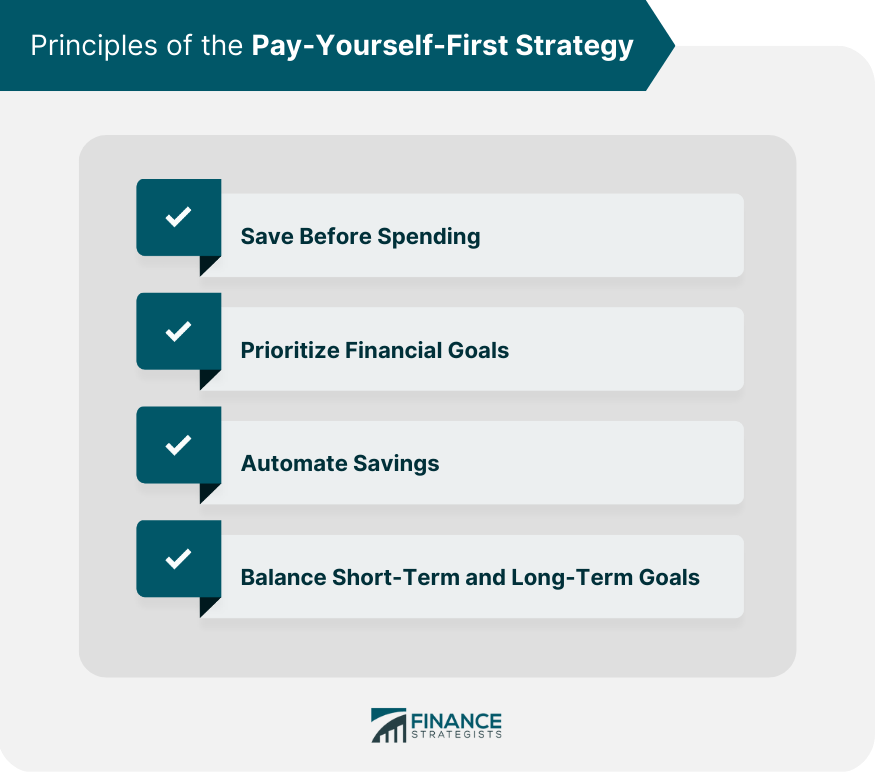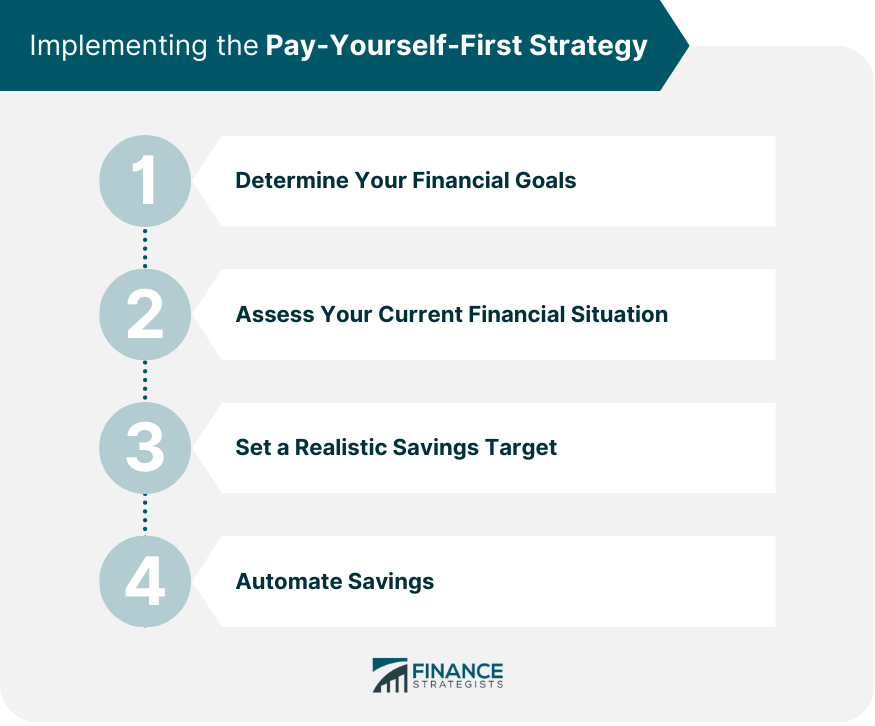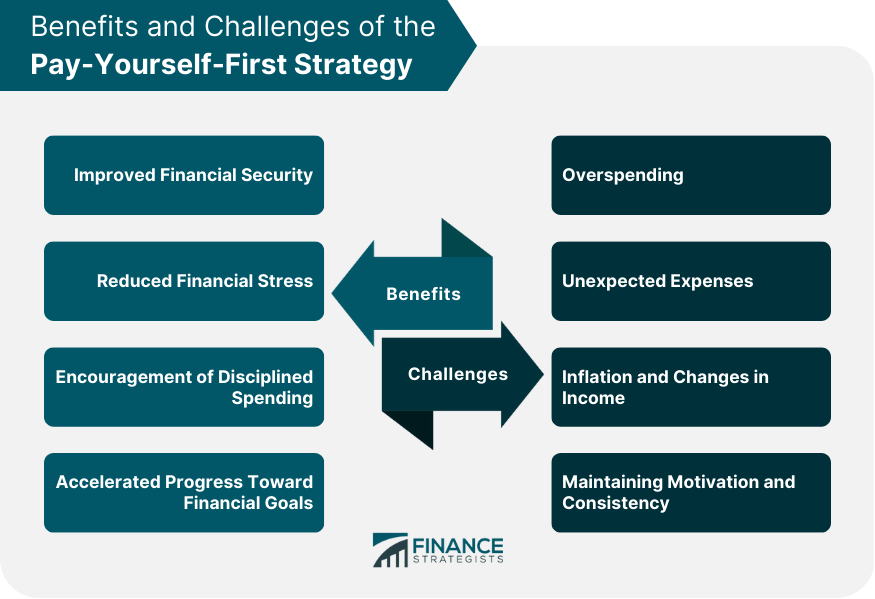The Pay-Yourself-First strategy is a personal finance approach where individuals prioritize saving money before spending on other expenses. It emphasizes the importance of financial planning and savings. Personal finance management is crucial for achieving financial stability, building wealth, and preparing for future uncertainties. It encompasses budgeting, saving, investing, and managing debt. The Pay-Yourself-First strategy aims to promote financial discipline, help individuals achieve their financial goals, and ensure they have a safety net for emergencies. Saving before spending involves allocating a portion of one's income to savings before paying bills or making discretionary purchases. It emphasizes the priority of saving in personal finance management. Prioritizing financial goals means identifying and focusing on essential financial objectives, such as building an emergency fund, paying off debt, and saving for retirement. It helps individuals make informed financial decisions. Automating savings involves setting up automatic transfers or direct deposits from one's paycheck to savings accounts, ensuring consistent savings without conscious effort. It simplifies the savings process and reduces the risk of overspending. Balancing short-term and long-term goals entails allocating funds to meet immediate needs while planning for future financial requirements. It ensures a well-rounded approach to personal finance management. An emergency fund is a critical financial goal, providing a safety net for unexpected expenses or income loss. It should ideally cover three to six months' worth of living expenses. Retirement savings are essential for ensuring financial security and maintaining one's standard of living in later years. Individuals should prioritize long-term investments in retirement accounts. Debt repayment is a key financial goal, as it reduces interest payments and improves one's credit score. It allows for better financial management and access to credit when needed. Saving for education and investment opportunities enables individuals to expand their knowledge and grow their wealth. It ensures long-term financial success and stability. Understanding one's income is vital for effective financial planning. It involves considering all sources of income, such as salary, bonuses, and investments. Assessing expenses involves tracking and categorizing all outgoing funds, including fixed and variable costs. It enables individuals to identify areas for potential savings and create a realistic budget. Debt analysis helps individuals prioritize debt repayment and develop a strategy for reducing debt over time. Addressing debt is essential for achieving financial freedom and improving overall financial well-being. Setting a savings target as a percentage of income allows for a consistent and proportional approach to saving. It ensures savings grow alongside income, promoting financial stability. Establishing a specific dollar amount for savings targets enables individuals to focus on specific financial goals. It promotes disciplined saving and accelerates progress towards achieving those goals. Direct deposit involves automatically depositing a portion of one's paycheck into a designated savings account. It simplifies the savings process and ensures consistency in saving efforts. Automatic transfers involve scheduling regular transfers from a checking account to a savings account. This approach ensures consistent savings and reduces the temptation to overspend. Various apps and tools facilitate automatic savings by rounding up purchases and transferring the difference to a savings account. They help individuals save effortlessly and build healthy saving habits. Low-income earners can adopt the Pay-Yourself-First strategy by starting with smaller savings goals and gradually increasing them as their financial situation improves. They should prioritize debt repayment and essential expenses. High-income earners can maximize the benefits of the Pay-Yourself-First strategy by allocating a higher percentage of their income to savings and investments. This approach accelerates wealth accumulation and long-term financial security. Freelancers and those with irregular income should adopt the Pay-Yourself-First strategy by setting aside a portion of their income during high-earning months to cover future lean periods. They should also prioritize building a robust emergency fund. The Pay-Yourself-First strategy enhances financial security by building a financial cushion for emergencies and providing a stable foundation for future financial endeavors. It reduces reliance on debt and external support. By prioritizing savings and financial goals, the Pay-Yourself-First strategy reduces financial stress by fostering a sense of control over one's finances. It promotes a proactive approach to personal finance management. Adopting the Pay-Yourself-First strategy encourages disciplined spending by ensuring individuals allocate funds to savings and essential expenses before making discretionary purchases. It cultivates healthy spending habits. The Pay-Yourself-First strategy accelerates progress towards financial goals by ensuring consistent saving and prioritizing essential financial objectives. It fosters steady growth in wealth and financial stability. Overspending can be mitigated by creating a detailed budget, tracking expenses, and setting limits on discretionary spending. Practicing mindful spending and differentiating between needs and wants can also help curb overspending. Unexpected expenses can be managed by maintaining a well-funded emergency fund and regularly reviewing one's financial plan to adjust for unforeseen events. Insurance coverage can also protect against high unexpected costs. Inflation and changes in income can be addressed by periodically reviewing and adjusting one's savings targets, financial goals, and investment strategies. Diversifying investments can also help hedge against inflation. To maintain motivation and consistency, individuals should set realistic financial goals, celebrate small victories, and periodically reassess their progress. Support from friends or family and joining financial communities can also help maintain motivation. Conducting regular financial check-ins helps individuals track their progress, identify areas for improvement, and make necessary adjustments to their financial plans. It promotes accountability and continuous improvement. Evaluating the success of the Pay-Yourself-First strategy involves measuring progress against set financial goals and assessing overall financial health. This process helps identify the effectiveness of the strategy and areas for refinement. Adjusting savings targets and financial goals is essential to accommodate changes in one's financial situation, needs, and priorities. Regularly reviewing and updating these targets ensures the strategy remains effective and relevant. The Pay-Yourself-First strategy significantly impacts financial well-being by promoting disciplined saving, reducing financial stress, and accelerating progress toward financial goals. It fosters a proactive approach to personal finance management. Consistent practice of the Pay-Yourself-First strategy is vital for achieving long-term financial success. Regularly saving and adjusting one's financial plan as needed promotes steady growth in wealth and financial stability. Adapting the Pay-Yourself-First strategy to individual circumstances is essential for maximizing its effectiveness. Tailoring the strategy to one's income, financial goals, and unique financial situation ensures a personalized and relevant approach to personal finance management. Seeking the guidance of a financial advisor can help individuals optimize the Pay-Yourself-First strategy and navigate complex financial decisions. Financial advisors can provide personalized advice, support, and accountability, ensuring the most effective implementation of the strategy.What Is Pay-Yourself-First Strategy?
Principles of the Pay-Yourself-First Strategy

Saving Before Spending
Prioritizing Financial Goals
Automating Savings
Balancing Short-term and Long-term Goals
Implementing the Pay-Yourself-First Strategy

Determining Your Financial Goals
Emergency Fund
Retirement Savings
Debt Repayment
Education and Investment
Assessing Your Current Financial Situation
Income
Expenses
Debt
Setting a Realistic Savings Target
Percentage of Income
Specific Dollar Amount
Automating Savings
Direct Deposit
Automatic Transfers
Apps and Tools
Adapting the Pay-Yourself-First Strategy for Different Financial Situations
Low-Income Earners
High-Income Earners
Freelancers and Irregular Income Earners
Benefits of the Pay-Yourself-First Strategy
Improved Financial Security
Reduced Financial Stress
Encouragement of Disciplined Spending
Accelerated Progress Toward Financial Goals
Common Challenges of the Pay-Yourself-First Strategy and Overcoming Them
Overspending
Unexpected Expenses
Inflation and Changes in Income
Maintaining Motivation and Consistency

Monitoring Progress and Adjusting the Strategy
Regular Financial Check-Ins
Evaluating the Success of the Strategy
Adjusting Savings Targets and Financial Goals
Final Thoughts
Pay-Yourself-First Strategy FAQs
The Pay-Yourself-First strategy is a personal finance approach that prioritizes saving money before spending on other expenses. It is important for promoting financial discipline, helping individuals achieve their financial goals, and ensuring they have a safety net for emergencies.
To implement the Pay-Yourself-First strategy, you need to determine your financial goals, assess your current financial situation, set a realistic savings target, and automate your savings through direct deposits, automatic transfers, or apps and tools.
Yes, the Pay-Yourself-First strategy can be adapted for different financial situations by adjusting savings goals, prioritizing essential expenses, and planning for irregular income. Tailoring the strategy to your unique financial situation ensures its effectiveness.
Common challenges include overspending, unexpected expenses, inflation, and maintaining motivation. These challenges can be overcome by creating a detailed budget, building an emergency fund, adjusting savings targets, and seeking support from friends, family, or financial communities.
Monitor your progress by conducting regular financial check-ins, evaluating the success of the strategy, and adjusting your savings targets and financial goals as needed. This ensures the strategy remains effective and relevant to your evolving financial situation.
True Tamplin is a published author, public speaker, CEO of UpDigital, and founder of Finance Strategists.
True is a Certified Educator in Personal Finance (CEPF®), author of The Handy Financial Ratios Guide, a member of the Society for Advancing Business Editing and Writing, contributes to his financial education site, Finance Strategists, and has spoken to various financial communities such as the CFA Institute, as well as university students like his Alma mater, Biola University, where he received a bachelor of science in business and data analytics.
To learn more about True, visit his personal website or view his author profiles on Amazon, Nasdaq and Forbes.











